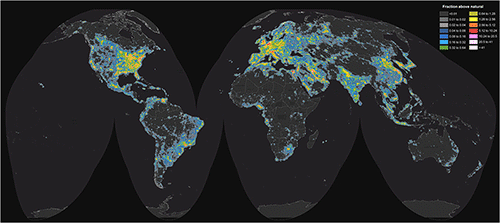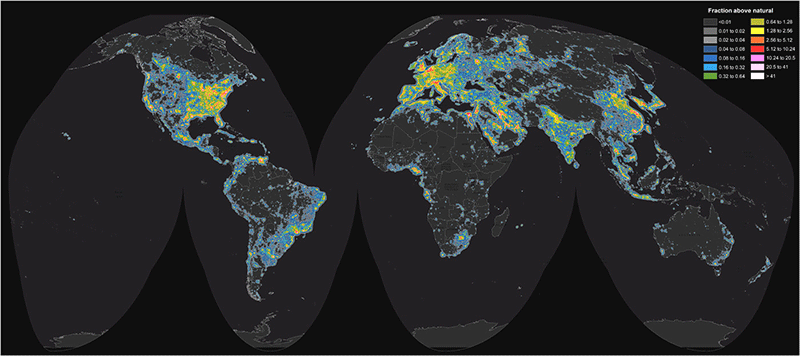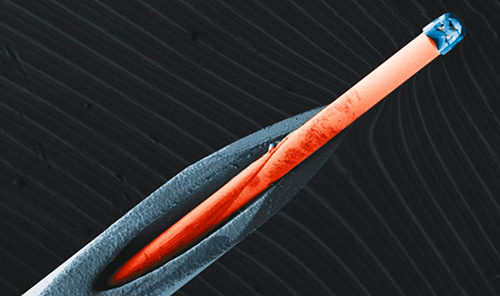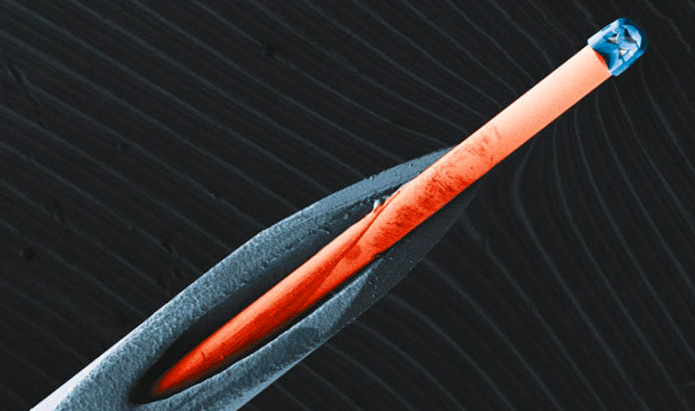Research News: Editors’ Choice
Global Light Pollution Masks the True Night Sky
To get the best view of a pristine night sky, you may have to travel far beyond city limits. Quantifying the extent of light pollution on a global scale, Falchi et al. report in Science Advances that the Milky Way is hidden from one-third of humanity. The Day Night Band (DNB) sensor aboard the Visible Infrared Imaging Radiometer Suite (VIIRS) is a high-resolution detector, capable of measuring the glow of vibrant cities from an altitude of 500 miles above the Earth’s surface. Averaging newly calibrated DNB data from select months in 2014, the team compiled a “world atlas” of artificial sky luminance. The atlas provides a global map of the zenith sky brightness (that is, directly overhead—generally the darkest part of the sky) to outline the locations that are the most impacted by artificial sky glow. The visual effects of light pollution are extensive—60% of the European Union population and nearly 80% of the United States population never experience a true view of the Milky Way, which is masked by an artificial twilight. Some communities—Middle Eastern countries in particular—experience extreme amounts of light pollution, where the majority of the population lives under skies so bright that the eye never adapts to pure night vision.
Making Lenses with Lasers
Researchers have demonstrated a new way to create tiny multicomponent lenses using laser 3D printing. Starting with a photoresist material that solidifies when it absorbs two photons at once, Gissible et al. write in Nature Photonics that they were able to manufacture multiple lens structures only 100 micrometers in diameter. This type of “additive” manufacturing (as opposed to cutting away material in subtractive processes), is a more sophisticated cousin of a 3D printing process that melts plastic and forms objects with computer control. The research group used a commercially available femtosecond-laser lithography system in which the laser beam is focused onto a substrate submerged in the photoresist. Scanning the laser builds up solidified material layer by layer according to a design created in an optical modeling program. Compared to conventional methods of glass grinding and polishing, the procedure allowed the researchers to fabricate multicomponent optical systems on smaller scales, such as tiny versions of camcorder lenses. Such submillimeter optics could find applications in medical and industrial imaging.
Perovskites for Stable and Efficient Solar Cells
Researchers have demonstrated solar cells based on perovskite materials that combine high power-conversion efficiency with long-term stability. Perovskites—minerals with an chemical formula—hold great potential for building efficient and cheap solar cells: With efficiencies exceeding 20%, perovskite-based photovoltaics are among the fastest advancing solar-cell technologies. Until recently, however, their stability under exposure to light and other environmental factors has been too poor for applications. Recent studies show that certain layered two-dimensional perovskite films, known as Ruddlesden-Popper phases, are more stable than 3D perovskites, but they typically feature efficiencies lower than 5%. Now, Tsai et al. report in Nature that they have more than doubled this value, demonstrating thin-film perovskite solar cells with 12.5% efficiency. The authors achieved this feat by producing thin films of near-single-crystalline quality, in which the planes have a special alignment that optimizes charge transport in a solar cell configuration. When subjected to a range of light, humidity, and heat tests, the devices showed little signs of degradation for over 2250 hours under standard illumination and showed much greater tolerance to humidity and heat stress than cells made from 3D perovskite materials.
Calculating an Inhomogeneous Universe
Two groups have now calculated the behavior of the Universe with fully relativistic numerical methods, starting with a realistic distribution of matter. Einstein’s equations for general relativity are hard to solve, so researchers typically use Newtonian simulations to deal with clumpiness. But doubts remain about these simpler models because they neglect some features of general relativity. As reported in Physical Review Letters and Physical Review D, Giblin et al. and Mertens et al., respectively, took methods developed for black holes and applied them to a clumpy Universe. They started with density perturbations based on observations and let them evolve according to general relativity. The group found local differences compared to models that aren’t fully relativistic. Independently, Bentivegna and Bruni performed a similar simulation, using different initial conditions. As described in Physical Review Letters, they found that the expansion rate is spatially dependent—faster than average in underdense regions, while overdense regions begin to gravitationally collapse in a shorter period of time than in previous models. These new results could improve the accuracy of cosmological models of galaxy formation and growth. (Adapted from the Physics article, “A Relativistic View of a Clumpy Universe.”)
Electrifying Chocolate Leads to Improved Sweets
Healthier and richer-tasting chocolate may be within reach, thanks to physics. Tao et al. report in the Proceedings of the National Academy of Sciences that applying an electric field to liquid chocolate reduces its viscosity by reorienting the solid cocoa particles. Flowing chocolate is a kind of liquid suspension: solid cocoa, milk, and sugar particles suspended within a base fluid of melted fats and oils. Attempting to increase the density of solid cocoa particles within the liquid suspension will make the flow clump or jam, unless the liquid fat content is increased. Tao et al. applied the electric field in the flow direction of the melted chocolate rather than perpendicular, as seen in traditional electric treatment methods, to align the particles into short chains (comparable to prolate spheroids) along the flow direction. This method allows chocolate to flow without jamming even if it has a higher density of cocoa particles. With the electric treatment, the team found that the viscosity of their liquid chocolate is identical to that of untreated chocolate even though they start with a 20% lower fat content. At the same time, they increased the cocoa content—giving the solid-state chocolate a stronger, darker flavor.







